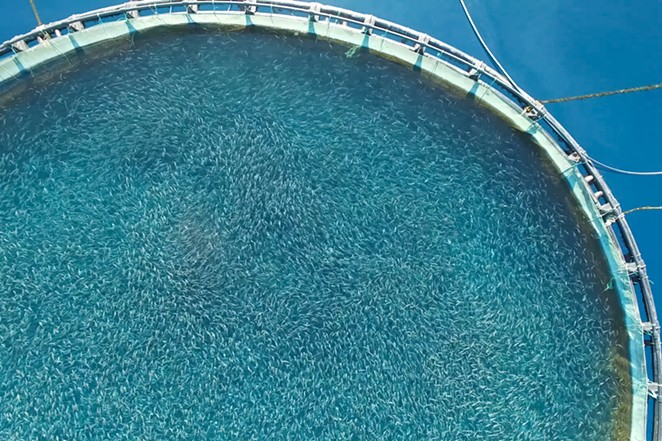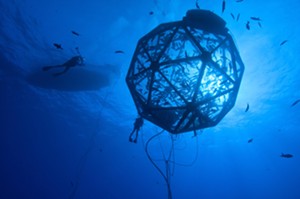Environmental advocacy groups, local fisheries, chefs, and law firms are working their way up the food chain to get President Joe Biden to revoke a Trump-era executive order allowing fish farms in federal waters—with eight potential sites identified in the Santa Barbara Channel.
“This is your backyard, and they are treating your backyard like a playground for industry to come in, pollute, and destroy local environment, local economies, and the local coastal communities,” said Andrianna Natsoulas, campaign director for Don’t Cage Our Oceans.

Offshore fish farms, or offshore aquaculture, uses fish cages that are submerged in deep water and cultivate fish, which can cause ecosystem damage and pollution, Natsoulas said
Don’t Cage Our Oceans is a national coalition of organizations and businesses that fight offshore fish farming through policy, legislation, and coalition building. It also supports wild-caught fish operations, community-based oyster and mussel farming, and seaweed farming, she said.
Along with calling for policy change, part of the organization’s work includes calling on Biden to revoke a 2019 executive order signed by then President Donald Trump—which made it easier for the National Oceanic and Atmospheric Administration (NOAA) to identify potential sites for fish farms in federal waters in order to improve the economy, remain competitive in the seafood industry, and have a reliable sustainable source of food, according to the Federal Register.
“The name of it, which is quite benign, promotes seafood competitiveness and economic growth, but in reality what this order focuses on is opening our federal waters to offshore fish farms,” Natsoulas said.
Although no one has claimed any of the 10 available federal sites—including those in the Santa Barbara Channel—Don’t Cage Our Oceans is circulating a petition, requesting Biden revoke the executive order in order to prevent any development and protect the environment.
“We will continue to pressure Biden to revoke this executive order that is not in the benefit of Americans, coastal communities, and our marine environment,” Natsoulas said.
Meanwhile, NOAA remains supportive of offshore aquaculture. Advocates say that the farms benefit local economies and create an environmentally sustainable source of food for the United States, and they’re pushing for a federal bill that would create a regulatory system for aquaculture in the country.
“These companies are just looking to fill their pockets; they are not looking to feed the people or support the communities or ecosystem,” Natsoulas said. “You have the communities that rely on tourism and [other] industries that will get decimated.”
Lauren Gaches, a NOAA spokesperson, told the Sun via email that aquaculture is vital for supporting the nation’s seafood production, year-round jobs, rebuilding protected species and habitats, and enhancing coastal resilience.
“Globally, aquaculture supplies more than 50 percent of all seafood produced for human consumption—and that percentage will continue to rise,” Gaches said. “At NOAA Fisheries, we support cutting-edge science and research as well as federal policy-making and regulation to grow sustainable aquaculture in the United States while supporting commercial and recreational fisheries.”
NOAA also supports science, policies, and regulations that allow communities to reap the social, economic, and environmental benefits of aquaculture, she added.
Don’t Cage Our Oceans Campaign Director Natsoulas said that offshore aquaculture would cause greater water pollution, ecosystem damage, marine mammal life loss, and algal blooms in nearby areas.
“Like pigs in a pen of a concentrated animal feeding operation, they are raising millions of fish at sea. What happens when you raise millions of one fish? Diseases spread. Parasites,” she said.
In order to manage disease and parasites, farmers mix antibiotics into the fish feed—which is then released by fish waste into the natural environment, Natsoulas said. The feed includes smaller fish that the entire marine ecosystem depends on and mixes soy and corn into the diet.
“We’re mixing genetically modified corn and soy into the fish’s feed. The problems pile on top, so that means genetically modified organism residue is coming out in fish waste and releasing into the ecosystem,” she said. “If the fish are not fed wild fish, the nutritional value declines.”

Cages also go missing or break open, Natsoulas said, releasing farmed fish into the wild that can often pass fatal diseases to other fish populations.
“This form of fish farming is devastating to the marine environment, it promotes a net loss of animal protein, and is ecologically unsustainable,” Natsoulas later added in an email. “There is a massive carbon footprint associated with the global sourcing, capturing, blending, and shipping of feed inputs to go into the fish feed, and related infrastructure associated with keeping them in cages, feeding them, medicating them, and harvesting them.”
If these fish are actually sold in the U.S., her email continued, farms will likely undercut wild fisheries and drive small businesses to closure. She cited Alaska as an example. The state banned farming in 1990 to protect the wild system the state depends on, according to the Alaska Department of Fish and Game.
“You’re talking about entire communities and dockside infrastructure and hundreds of families that depend on fishing,” she told the Sun. “These fish farms are not owned by community members, it’s not private business, it is fish farms that get backing from huge corporations that are outside the U.S.”
Drue Banta Winters, the campaign manager for Stronger America Through Seafood—a national organization that represents companies across the seafood supply chain—said that the U.S. currently imports 85 percent of the seafood it consumes and added that offshore aquaculture would help supply a source of protein in a sustainable and healthy way.
“We are already eating farm-raised fish; it’s just coming from other countries. Why wouldn’t we do this and build that industry here? It just makes sense while we’re safeguarding our seafood supply and a healthy source of protein,” she said.
Fish receive precise diets with soy, insects, algae, and seaweed. Antibiotics are used as an absolute last resort, she said, and farmers tend to use probiotics or vaccinations instead. Escapes rarely happen, she added, due to advanced technology and monitoring.
“Opponents are citing water quality, disease, and escape, and use of antibiotics as reasons that offshore aquaculture is not environmentally friendly, [but] much has changed over the past 20 years,” Winters said. “Siting is the best way to reduce water quality impacts—the right place, with the right current and depth. The ability to site a farm has changed the landscape around aquaculture.”
Aquaculture operations are also subject to heavy environmental regulation, taking years to get through the permitting process, and offshore aquaculture siting—picking the specific areas for fish farms—is environmentally sustainable, avoids conflicts with other users, and mitigates impacts to marine mammals, Winters said.
As wild capture is impacted by climate change, revoking the executive order would be “unfortunate” for the U.S. because it would take away the ability to create a steady supply of fish coming into ports—which could create long-lasting jobs in coastal communities, she said.
Now, Stronger America Through Seafood is advocating for the bipartisan Advancing the Quality and Understanding of American Aquaculture (AQUAA) Act: a federal bill that would establish a regulatory permitting system for offshore aquaculture, Winters said. It wouldn’t eliminate any environmental regulations; rather it gives certainty to which federal agency oversees the industry and sets a national plan to find sites well suited for aquaculture.
The bill was reintroduced in October 2021 by U.S. Sens. Marco Rubio (R-Florida), Roger Wicker (R-Mississippi), and Brian Schatz (D-Hawaii) after the senators first introduced the legislation in 2020.
“Climate change is changing the dynamics of fisheries and changing ocean conditions,” Winters said. “I think from both sides of the aisle we understand the AQUAA Act is a bipartisan bill and safeguards our seafood supply.”
Reach Staff Writer Taylor O’Connor at [email protected].


